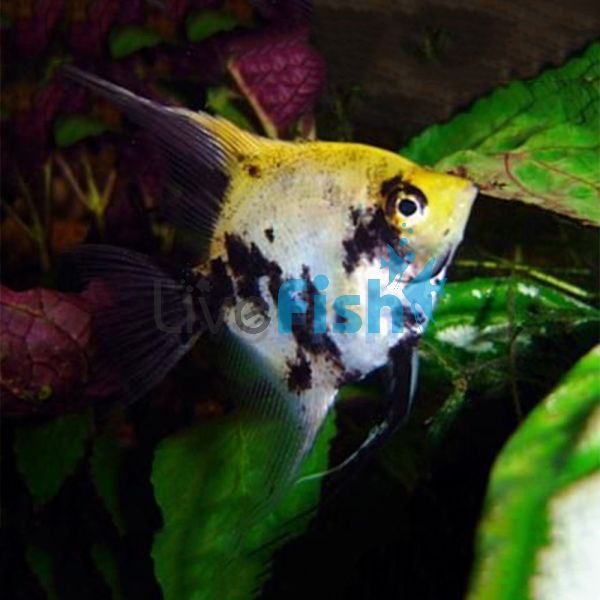Koi Angelfish 8cm
The Koi Angelfish is an interesting colour morph. With its Black and White Blotches along with a gold hue on its head makes a stunning addition to your Aquarium.
Koi angelfish swiftly skyrocketed to be one of the most popular angelfish colour strains that are at times, more common to find than the standard angelfish colour. The diversity of colour variations and how no 2 fish look the same make this a popular fish for aquarists chasing variety and even for breeders to play around with colours. Angelfish in general are one of the most recognizable aquarium fish species and are actually a member of the cichlid family. Unlike most cichlids which are recognized as being aggressive species that are not suitable in community aquariums, the angelfish is the stark opposite of this. They make for great centrepiece fish in community aquariums and are very easy to keep.
- Buy 2 for $47.58 each and save 10%
- Buy 4 for $42.30 each and save 20%
- Buy 8 for $37.01 each and save 30%
Koi Angelfish
Koi angelfish swiftly skyrocketed to be one of the most popular angelfish colour strains that are at times, more common to find than the standard angelfish colour. The diversity of colour variations and how no 2 fish look the same make this a popular fish for aquarists chasing variety and even for breeders to play around with colours. Angelfish in general are one of the most recognizable aquarium fish species and are actually a member of the cichlid family. Unlike most cichlids which are recognized as being aggressive species that are not suitable in community aquariums, the angelfish is the stark opposite of this. They make for great centrepiece fish in community aquariums and are very easy to keep.
Koi angelfish get their name due to the resemblance they share with the patterning koi fish. The mix of 3 colours and random patterning is something commonly seen in Showa koi. Koi angelfish tend to predominately have yellow, white, and black, the yellow tends to streak across the nape of the fish with a platinum-white underbelly. The black appears as blotches and speckling across the fish and they are generally in random locations on every fish. Angelfish are one of the first species that aquarists will breed because of how proficiently these fish spawn in the aquarium. A lot of fun can be had experimenting with colours and genetics in this strain by trying to isolate the black to specific locations or attempting to deepen the yellow colour. Different strains can be kept together as well to create a stunning mixed angelfish aquarium. These angelfish fall into the scalare species meaning they can get fairly big however they have a very slim profile, almost looking like an arrowhead gliding in the aquarium.
Trying to find the males and females in not only the koi angel but angelfish, in general, is somewhat difficult when they are small, however dominant males will develop a small hump on their heads. One can be 100% certain only when a breeding pair is formed. The best way to ensure this happens is to start with a small group of 5-6 fish and let them pair off naturally. Koi angelfish are not found in the wild as they are a captive bred and manmade colour variation however the angelfish in general is from South America.
Tank Recommendations for your Koi Angelfish
As the Koi angel is a colour variation of the common scalare angelfish species meaning it has the same aquarium needs as any other angelfish variety. At full adult size, they reach around 15 cm long and a decent 20 cm tall, because of this they would need to be kept in a tank that is at least 100 litres.
Koi angelfish are not exactly a solitary species and should be kept in mated pairs or shoals. However they will need space as they can be territorial at times, so having a good footprint in the aquarium is always best. A sand or gravel substrate is perfectly fine, but a well-planted aquarium with lots of branching driftwood and rock will be greatly appreciated by these angelfish.
Suitable Tank Buddies
The Koi angelfish is fairly peaceful with aggression only ever coming out during breeding males however they may eat very small fish fry and shrimp. With adequate space, these fish will get along with a wide range of community fish. it has however been noted that angelfish can possibly be aggressive against fish species that look similar.
Usually Compatible
Other angelfish, tetras, gouramis, corydoras, angelfish, barbs dwarf cichlids such as rams and large peaceful cichlids such as uaru or Severums.
Sometime Compatible
Semi-aggressive or territorial cichlids like fire mouths, convicts cichlids and similar species.
Rarely Compatible
large aggressive species such as African cichlids, Oscars and Jaguar cichlids.
Feeding your Koi Angelfish
Angelfish in general are a very easy species to feed that will take to a wide range of aquarium foods like pellets or flakes. They are naturally an omnivore that feeds off plant matter like algae, small insects and crustaceans. This means a well-balanced aquarium food which has good protein and green content would be best.
| Scientific Name | Pterophyllum scalare |
|---|---|
| Care Level | Moderate |
| Common Names | Koi Angelfish |
| Diet | Omnivore |
| Fish Family | Cichlidae |
| Lifespan (years) | 10 |
| Max. Length (cm) | 15 |
| Min. Tank Volume (l) | 100 |
| Origin | South America |
| Reef Safe | Yes |
| Sociability | Peaceful |
| Venomous | No |
| Water Conditions | 24-26° C, pH 5.0-7.0 |




